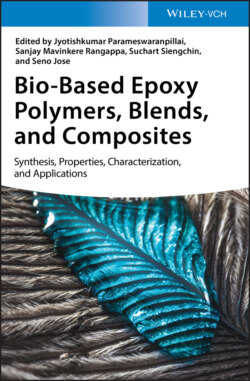Читать книгу Bio-Based Epoxy Polymers, Blends, and Composites - Группа авторов - Страница 13
1.1 Introduction
ОглавлениеThe term “epoxy resin” is understood to mean compounds containing at least one active epoxy group in their structure and which are capable of forming a cross‐linked three‐dimensional structure in the curing process involving these groups. Naturally, epoxy rings are found only in vernonia oil. However, epoxy functionality can be easily introduced into the compound structure, even by the oxidation of unsaturated bonds to oxirane rings. This is a typical method of obtaining cycloaliphatic resins, applied on a large scale in electronics to encapsulate electronic systems. The second method is the use of epichlorohydrin, which is commonly applied to prepare epoxy compounds via the reaction with polyalcohols or polyphenols. Epichlorohydrin together with bisphenols (mainly bisphenol A or F, and S) are the main raw materials used in industrial methods for the synthesis of epoxy resins most often produced and used on a large scale. All these compounds are of petrochemical origin. There are three main reasons for the search of new raw materials of natural origin for the synthesis of epoxy resins. The first is the need to replace petrochemical raw materials. The volatility of oil and gas prices and their strong connections with the changing political situation in various regions of the world, as well as the inevitable prospect of imminent exhaustion of their sources, and ecological considerations are the main reasons for the search of alternative sources of raw materials. Moreover, potential toxicological and endocrine disrupting properties of bisphenol A are discussed and emphasized, especially in recent years. The second reason is the need to solve the problem of annually increasing amount of postconsumer plastic waste. Epoxy resins belong to the category of polymeric materials practically not biodegradable. The application of bio‐based raw materials can enable and facilitate their decomposition under the influence of biological factors. Epoxy resins are widely used as coating materials in products intended for contact with food or even storage of food (e.g. can‐coating or paints for securing ship hold walls). Therefore, the third reason is the need to limit the penetration of harmful substances such as bisphenol A into food from the coating material, preferably by eliminating them already at the stage of synthesis.
While searching for new bio‐based resources for the synthesis of epoxy resins, particularly bisphenol substitutes, the crucial issue must be remembered. One of the most important challenges is to provide new bio‐based resins with comparable performance properties to the currently manufactured and applied petrochemical‐based commercial products, i.e. primarily high mechanical strength, thermal stability, and chemical resistance. The mentioned properties are characteristic of the resins based on bisphenol A (or other bisphenols), thanks to which these materials are produced on a large scale for many applications. Therefore, this chapter presents the most promising raw materials whose structure can provide the desired final properties of the epoxy system after cross‐linking. At the same time, they must be raw materials easily available in large quantities from renewable sources, nontoxic and cheap to obtain and in preparation.
